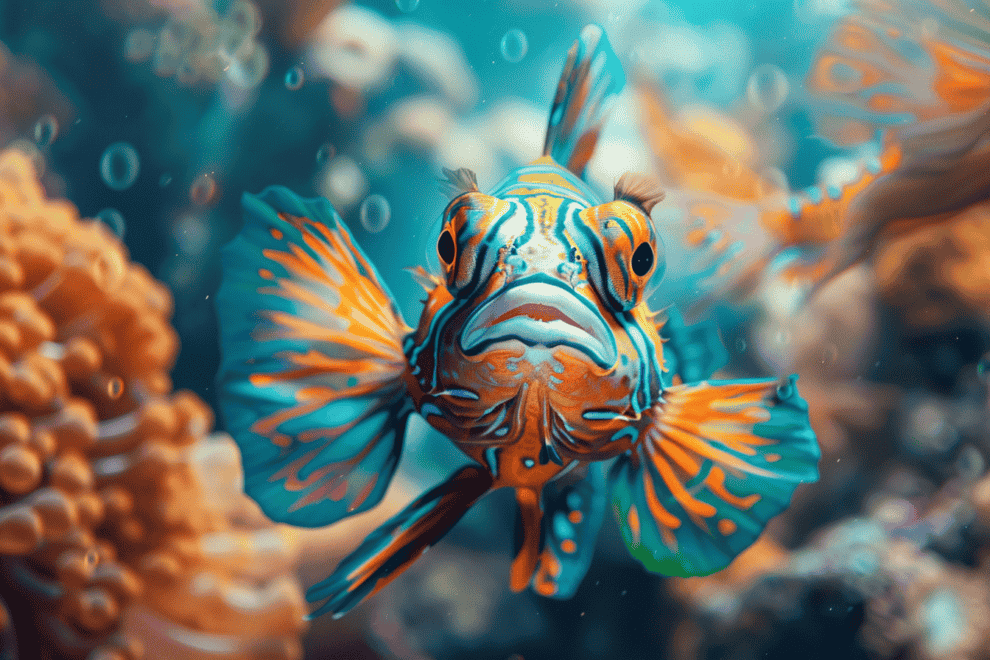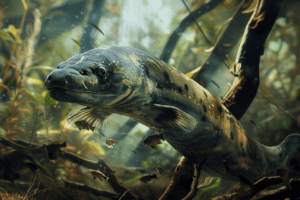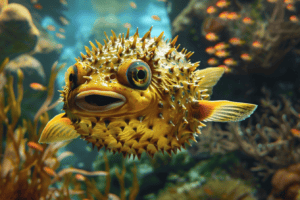In the vibrant depths of the Pacific Ocean’s reefs, a mesmerizing spectacle awaits. Among the coral and seaweed, a tiny, psychedelic marvel flits about – the mandarinfish.
With its dazzling blue and orange stripes, this small but mighty fish has evolved a remarkable arsenal of defenses to survive in its underwater world.
From its toxic mucus coating to its foul-smelling secretions, the mandarinfish has developed a range of strategies to deter predators and thrive in its delicate ecosystem.
But beyond its striking appearance and impressive survival tactics, there’s more to discover about this fascinating fish.

The mandarinfish boasts a vibrant blue and orange-striped pattern that not only catches the eye but also helps deter predators. This psychedelic display is more than just a pretty facade; it’s a survival mechanism.
The blue coloration is produced by cyanophores, specialized cells that reflect blue light, making the mandarinfish one of the few species capable of generating its own blue pigment. These vivid colors create an illusion of toxicity, discouraging would-be attackers.
The mandarinfish is scaleless, but its skin is far from defenseless. It’s covered in tiny spines that can inject a poisonous mucus into predators. This thick mucus serves a dual purpose: it protects the fish from rough environmental elements and releases a foul-smelling toxin.
This combination of visual and chemical defenses makes the mandarinfish a less appealing target for predators.
At just three inches long, the mandarinfish packs a lot of defensive features into its small frame. Its striking appearance and complex defense mechanisms make it a fascinating subject for anyone interested in marine life.
The bright blue and orange stripes, thick mucus, and tiny spines all contribute to its unique and mesmerizing presence in the underwater world.
Where Is The Mandarinfish Found?

Beyond its mesmerizing appearance and sturdy defenses, the mandarinfish thrives in the vibrant lagoons and inshore reefs of the Pacific Ocean, particularly from Japan’s Ryukyu Islands to Australia.
You’ll often find them in shallow waters, typically at depths of 1 to 20 meters, where coral reefs flourish. These fish prefer areas with low to moderate currents, making sheltered lagoons and seaweed beds their ideal homes.
Mandarinfish are members of the dragonet family, and they’re one of the rare species that can produce their own blue pigment proteins, adding to their striking visual appeal.
This unique adaptation helps them blend into the colorful coral reefs, providing both camouflage and a breathtaking spectacle for divers and marine enthusiasts.
However, their habitat faces significant threats. Coral reef destruction, due to human activities and climate change, impacts their population and distribution.
The delicate balance of their ecosystem means that any disruption can have severe consequences. To spot these little gems, you need to look closely among the coral structures and seaweed beds where they hide.
Their survival depends on the health of the coral reefs, making conservation efforts crucial for their continued existence.
How Does The Mandarinfish Defend Itself?

Boasting a unique defense mechanism, mandarinfish secrete a toxic mucus that deters predators and keeps them safe amidst the vibrant coral reefs. This toxic mucus defense not only makes them unpalatable but also produces a foul stench, warning potential threats to stay away.
The mandarinfish, scientifically known as Synchiropus splendidus, employs this natural armor to survive in a habitat teeming with danger.
When a predator attempts to take a bite, it’s met with a mouthful of the mandarinfish’s toxic mucus. This mucus can cause irritation or even an open wound, making the predator think twice before attacking again.
The tiny mandarinfish turns this slimy shield into a powerful advantage, allowing it to swim freely without constant fear of being eaten.
The vibrant colors of the mandarinfish serve as a visual warning as well, signaling that they aren’t a desirable meal. This combination of visual and chemical defense is a brilliant strategy, ensuring their survival in the competitive underwater world.
What Do Mandarinfish Eat?

Mandarinfish have a specialized diet that primarily consists of live food, making it essential to provide a steady supply of copepods and small crustaceans in their aquarium. They are quite particular about their meals, often ignoring anything that isn’t moving.
In the wild, Mandarinfish thrive in inshore reefs and sheltered lagoons, where their natural habitat is covered in tiny organisms. They continuously forage, using their keen eyesight to spot minute prey hidden amongst the coral and rocks.
This constant grazing behavior means you’ll need to make certain a plentiful and continuous supply of live food is available in their tank.
For a healthy Mandarinfish, it’s vital to replicate their natural feeding and diet as closely as possible. Setting up a refugium or a well-established live rock system can help sustain a population of copepods and other microfauna.
You might also consider supplementing their diet with live brine shrimp or amphipods to keep them well-fed and content.
Breeding Behavior

Understanding the breeding behavior of Mandarinfish can enhance your ability to successfully breed them in captivity. These vibrant fish have a unique and enchanting mating dance that you’ll find fascinating. When the male and female are ready to mate, they perform a synchronized, spiraling dance that often takes place at dusk. This dance isn’t just for show; it plays a pivotal role in their breeding behavior.
To create an environment that meets Mandarinfish needs, you should include plenty of branching corals in your tank. These corals provide the essential hiding spots and territorial boundaries that Mandarinfish require. During the mating process, the male and female rise together, releasing eggs and sperm into the water column simultaneously. This synchronized release increases the chances of fertilization.
The right tank conditions, like stable water quality and ample space, are essential for successful breeding. You’ll also notice that males can be territorial, so having multiple hiding spots can reduce stress. By understanding these intricacies of Mandarinfish breeding behavior, you’ll be better equipped to create a thriving captive environment for these stunning, psychedelic fish. Their mesmerizing mating dance and unique needs make them a rewarding challenge for any aquarist.
Frequently Asked Questions
How Long Do Mandarinfish Typically Live in the Wild?
In their reef habitat, mandarinfish typically live 8-10 years in the wild. Their lifespan depends on diet habits, reproductive behavior, and growth stages. Lifespan factors also include predation and environmental threats like coral bleaching and habitat destruction.
Are Mandarinfish Social or Solitary Creatures?
You’re wondering if mandarinfish are social or solitary creatures. They exhibit social hierarchy during mating behavior and territorial disputes. Their group dynamics and habitat preferences influence how they interact within their environment.
Do Mandarinfish Have Any Natural Predators?
Yes, mandarinfish have natural predators. However, their Mandarinfish defense mechanisms, like Coral camouflage and blending with Reef inhabitants, help in predator avoidance. They face natural threats from larger fish, but their vibrant colors offer some protection.
Can Mandarinfish Change Their Colors?
No, mandarinfish can’t change their colors. Their pigment composition and fixed chromatophore function mean they lack the color adaptation seen in other fish. Environmental influence and stress response don’t affect their vibrant hues.
What Is the Scientific Name of the Mandarinfish?
The scientific name of the mandarinfish is Synchiropus splendidus. When researching their scientific classification, you’ll find they prefer coral reefs, exhibit unique breeding habits, have a stable conservation status, and display fascinating feeding behavior.








